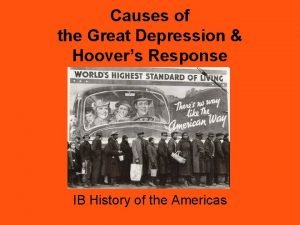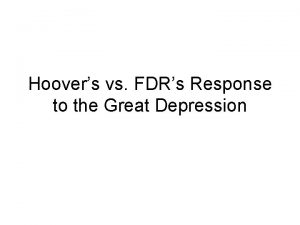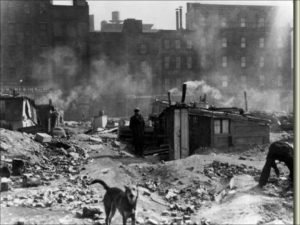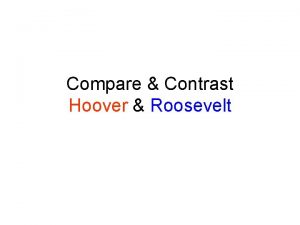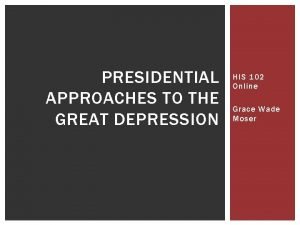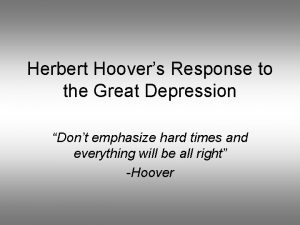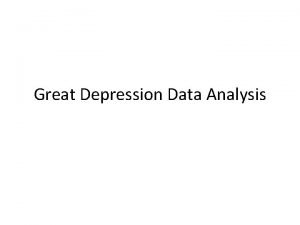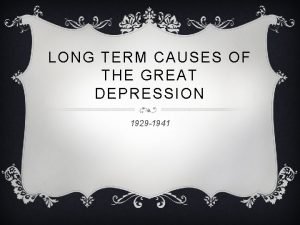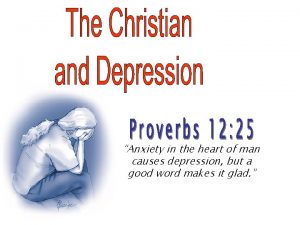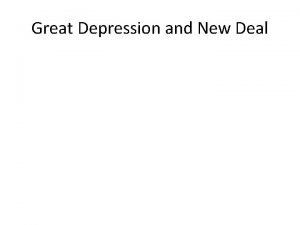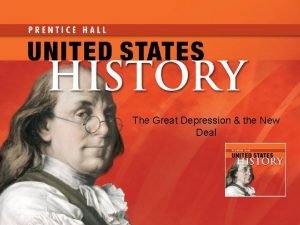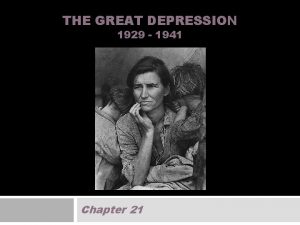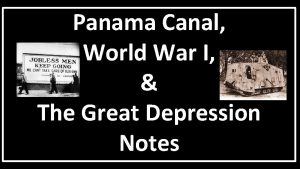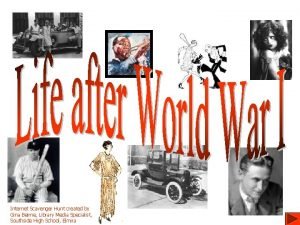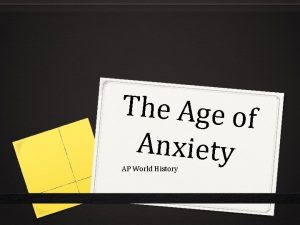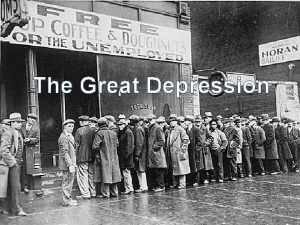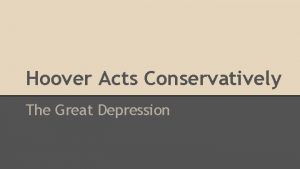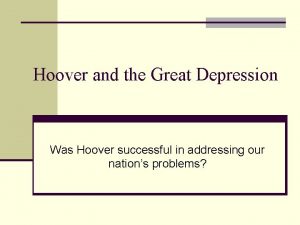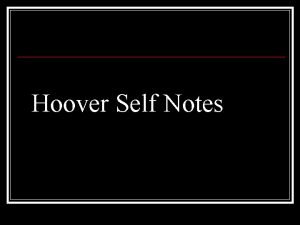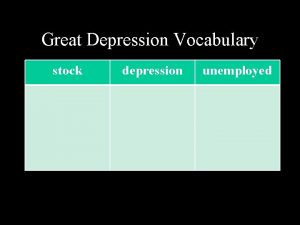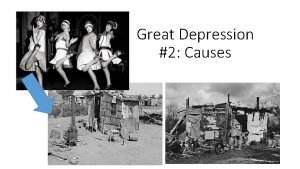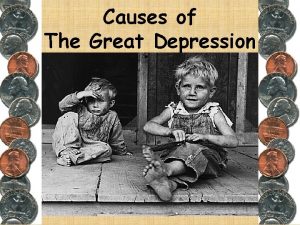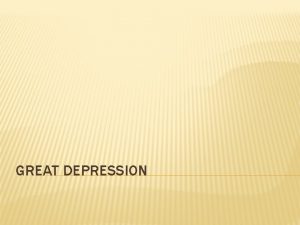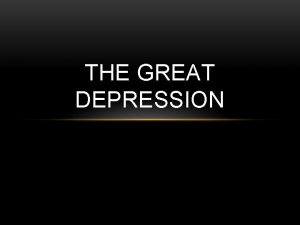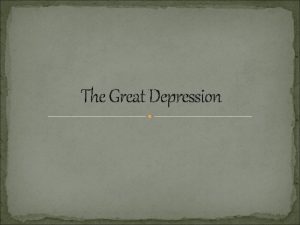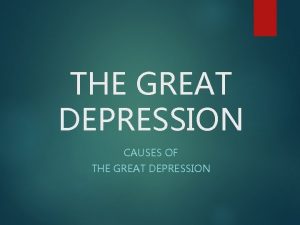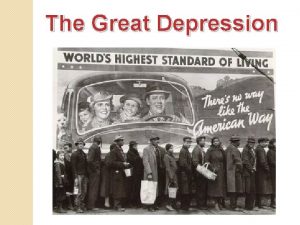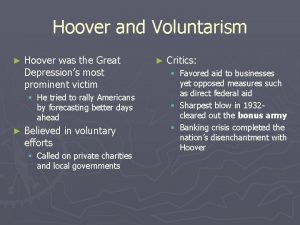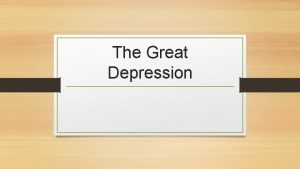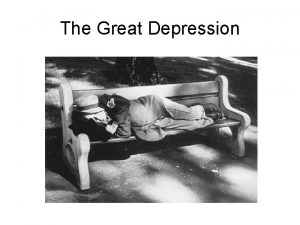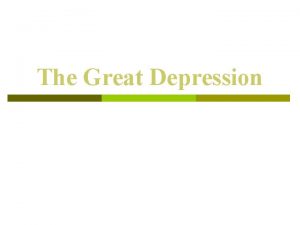Causes of the Great Depression Hoover Charting Causes




















- Slides: 20

Causes of the Great Depression Hoover

Charting Causes of the Great Depression Cause Definition & How it Contributed to the Great Depression Over Production • By the end of the 1920 s, factories produced too many durable goods (known as over-production) People did not need as many appliances and cars by the end of the decade (under-consumption) ( too much inventory, not enough buyers) Farming Problems • Problems for farmers and industry -Railroads, textiles, coal were losing money and faced competition from cars, synthetic fabrics, natural gas. • During WWI, prices rose and international demand for crops such as wheat and corn soared. The end of WWI led to a decline in demand for agricultural products and a 40% decline in crop prices • Farmers boosted production. Farmers could not pay back loans and many had their farms foreclosed. Rural banks also began to fail. Congress tried to help farmers out by implementing price-supports Note: (The government would buy surplus crops at guaranteed prices and sell them on the world market. but Pres. Coolidge vetoed the bill.

Causes Definition & How it Contributed to the Great Depression Living on Credit • Used credit to live beyond their means. This was often in the form of an installment plan (usually in monthly payments) that included interest charges. Uneven Distribution • Americans generated large debts, and had to cut back on spending by the end of the decade. • Wealthiest 1% of population rose by 75%, compared to 9% increase as a whole for all Americans. 70% of Americans were considered “poor” (earned less than 2, 500 year) so most of the spending was done by 30% of the population. • Note: Economists estimate that the average man or woman bought a new outfit of clothes only once a year. Scarcely half the homes in many cities had electric lights or a furnace for heat. Only one city home in ten had an electric refrigerator. This unequal distribution of income meant that most Americans could not participate fully in the economic advances of the 1920 s.

Causes Definition & How did it contribute to the Depression? Stock Market Speculation • People were engaging in speculation—that is, they bought stocks and bonds on the chance of a quick profit, while ignoring the risks • The stock market soared throughout the 1920 s and people speculated by buying on margin. Buy on Margin • Paying a small percentage of a stock’s price as a down payment and borrowing the rest. • The stock market was not regulated which allowed some companies to alter their stock values to increase profits… This created a “bubble” in the stock market. If value of stock declined, borrowers had no way to pay off stock. On October 29, 1929 (Black Tuesday) the stock market crashed. Black Tuesday—the bottom fell out of the market and the nation’s confidence. People rushed to sell, stock prices dropped, and investors lost a total of $30 billion. Speculators who bought on the margin, could not pay off their debts

After the crash, people tried to withdraw their money from banks When banks could not produce money for all their customers, (b/c they invested in the stock market) the banks failed This led to a run on banks across the U. S… hundreds of banks failed (In 1929, 600 banks closed. By 1933, 11, 000 of the nation’s 25, 000 banks had failed) and thousands of people lost their savings The banking failure and stock market crash led to the collapse of thousands of businesses

The Great Depression led to a global depression in Europe, Asia, and Latin America World trade fell by 40% To encourage citizens to buy from U. S. companies (not foreign competitors) the government passed new high tariffs… …European nations responded with their own tariffs which made it difficult for U. S. companies to sell their goods overseas

When the Great Depression began, millions of people lost their jobs or took pay cuts to keep their jobs From 1929 to 1932, unemployment grew to 12 million people Americans lacked confidence in the future so they tried not to spend money The decline in consumer confidence made the depression drag on until the 1940 s

The Great Depression led to a collapse of the American financial system by 1933 Americans lost confidence in banks as 25, 000 banks failed; The lack of banking meant there was no money for investment The lack of spending and stock market crash led to failure of 90, 000 businesses Unemployment peaked at 25% of all Americans; People lost their homes, farms, and businesses The USA had record poverty and suicide rates and healthcare declined; Charities offered soup kitchens and breadlines to help

The effects of the depression were made worse by the Dust Bowl Decades of over-farming and droughts in the Plains led to windstorms that swept away soil and made farming impossible Farmers in the Plains (called “Okies” and “Arkies” left their farms and searched for work or for better land in West coast states Dust Bowl

When the Great Depression began, Republican President Herbert Hoover tried to solve America’s economic problems President Hoover believed that America could overcome the depression through “rugged individualism” (using hard work and perseverance) Rugged Individualism- that local organizations and charities should provide direct relief Hoover private charities to help (“volunteerism”) He encouraged business growth, wanted to keep taxes low, and avoided direct gov’t intervention

National Credit Corporation • Hoover tried to ease the nation’s credit crisis with the creation of the NCC • The NCC held a pool of private money that it could lend to banks so that banks could continue to offer loans; the NCC, however, never had enough cash to meet the demand so was a failure

As the depression worsened, Hoover called for more direct government action to ease peoples’ suffering Under Hoover, the gov’t Congress created the issued relief checks to Reconstruction Finance help the unemployed Corps (RFC) to loan money to save failing businesses ■ When the NCC failed, Hoover resorted to government lending ■ The RFC was created to make direct loans to banks & railroads ■ Even the RFC could not meet the demands for loans, and the economy continued to fail

Congress approved new building projects ( Emergency Releif & Construction Act) to put Americans to work like the Hoover Dam ■ One of Hoover major efforts to address the economic crisis was the 1930 Federal Farm Board. ■ Did not work.

Hawley-Smoot Tariff • Designed to help famers, it was expanded to include large number of consumer goods • established the highest protective tariff in United States history. • When European nations responded with tariff on American goods, international trade dropped dramatically. BY 1934 trade was down twothirds from its level in 1929 • Another trigger/cause for world wide depression

Events Effects of the Great Depression Hunger Marches Crowds of the unemployed and hungry began to hold large-scale demonstrations across the US. Protesters chanting “Feed the hungry, tax the rich” were blocked from marching by the police Farmers began to destroy their crops and produce in an effort to increase prices. Some even resorted to burning their crops for heat in their home. Anger continued to grow as more and more farmers had their land foreclosed on by banks Farmers Revolt Breadlines and Soup Kitchens As unemployment approached 30%, many people began to rely heavily on soup kitchens and breadlines run by churches, charitable organizations, & some city governments in order to survive Hobos Hundreds of thousands of homeless, jobless men began to live a nomadic lifestyle, moving from place to place usually by illegally hiding on freight trains. Often lived in temporary Hoovervilles called “hobo jungles” along the railroad tracks Hooverville's In large cities, as people could no longer afford to pay rent, they were forced into homelessness. Many began to live in homemade shacks that they built in any open space available – whole villages of such shacks began to appear, mockingly referred to as “Hoovervilles”

Americans who lost their homes, lived in shantytowns nicknamed “Hoovervilles” “Hoover Hotels” “Hoover Blankets” “Hooverville”

The Bonus Army • In 1924, Congress had promised to pay every WWI veteran a $1000 bonus in 1945 • May 1932 – over 15, 000 vets arrived in DC to lobby Congress to move the bonuses up – Congress voted against the idea • After the vote, much of the Bonus Army remained in Washington, living in Hooverville's and vacant buildings • Pres. Hoover ordered them dispersed; after the DC police failed, Hoover sent in US Army, who used tear gas and bayonets to clear the Bonus Army out

By the election of 1932, Americans were looking for new leadership and a president who could save them from the Great Depression ■ Republicans nominated Hoover, while Democrats ran NY Gov. Franklin Delano Roosevelt ■ Hoover continued his mantra that recovery was just around the corner, while Roosevelt pledged himself to a “new deal” for the American people ■ Roosevelt won easily

Creating a Plan to Get America out of the Depression Although historians and economists differ on the main causes of the Great Depression, most cite a common set of factors, among them: 1) tariffs and war debt policies that cut down the foreign market for American goods 2) a crisis in the farm sector 3) the availability of easy credit 4) an unequal distribution of income 5) Bank failures 6) Stock market speculation and buying on margin 7) bank failures These factors led to falling demand for consumer goods, even as newly mechanized factories produced more products. The federal government contributed to the crisis by keeping interest rates low, thereby allowing companies and individuals to borrow easily and build up large debts. At first people found it hard to believe that economic disaster had struck. In November 1929, President Hoover encouraged Americans to remain confident about the economy. Yet, the most severe depression in American history was well on its way.

Group Activity: Saving the Future! Get Us Out of the Depression Instructions: With a partner, you will play the role of an economist/advisor future president FDR. Your job is to help provide him a plan to get the economy out of the depression so he can win the election. You will have to give him the pros and cons of the plan so he can evaluate which plan to choose. Your plan should include the following steps: Step #1 - Identify the goal and what is the problems. Step #2 - Brainstorm 6 -9 ways to fix the problems. Step #3 - Pick 2 plans out of step #2, give the plans a name, and list the Pro’s and Con’s of each plan.
 What was hoover's response to the great depression
What was hoover's response to the great depression Hoover v. fdr: responses to the great depression
Hoover v. fdr: responses to the great depression What was hoover’s response to the depression?
What was hoover’s response to the depression? Compare and contrast hoover and fdr
Compare and contrast hoover and fdr Herbert hoover great depression political cartoon
Herbert hoover great depression political cartoon Hoovers response to the great depression
Hoovers response to the great depression Great depression causes
Great depression causes What were the long term causes of the great depression
What were the long term causes of the great depression Chapter 14 section 3 hoover struggles with the depression
Chapter 14 section 3 hoover struggles with the depression Anxiety in the heart of man causes depression
Anxiety in the heart of man causes depression Great depression vocabulary jeopardy
Great depression vocabulary jeopardy Hoovervilles great depression
Hoovervilles great depression Laissez faire great depression
Laissez faire great depression The ingenious quarterback
The ingenious quarterback Http://www.history.com/topics/great-depression
Http://www.history.com/topics/great-depression What was the great depression
What was the great depression Roaring twenties scavenger hunt answers
Roaring twenties scavenger hunt answers Great depression ap world history definition
Great depression ap world history definition Great depression
Great depression Chapter 22 the great depression begins
Chapter 22 the great depression begins Hardship and suffering during the depression
Hardship and suffering during the depression
